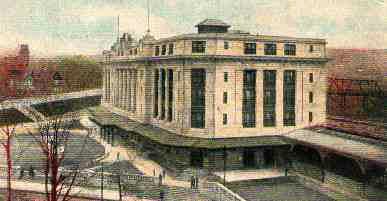Extending the Reach of Regional Rail
Posted by Glenn on September 2, 2006 - 8:47pm in The Oil Drum: Local

Scranton Rail Station
New York City boasts one of the nation's best, if not the best and most extensive regional rail systems connecting Manhattan to major hubs in Long Island, Westchester, Fairfield County Connecticut through the Metropolitan Transit Authority and almost all of the major cities and towns in New Jersey through NJ Transit and the PATH trains. From there, rail connections can be made to Amtrak connecting to the rest of the Northeast Corridor and beyond. However, there are many small cities and towns that used to be connected to the national and regional rail network that served as regional hubs for transportation that were cut-off as automobiles became the dominant form of intercity travel. Their populations drifted to the hinterland and municipalites lost their core.
But now, with the green light for the new Trans Hudson Tunnel and as gas prices have increased, small towns & cities across the region are attempting to reconsolidate their former importance as regional centers of commerce and population, restoring regional rail. Starting with Scranton

Lakawanna Cut-off Connection to Hoboken/NYC
Rail service ended in 1970 in Scranton. Scranton lies at the pivot point between northern New Jersey and the Southern Tier of Upstate New York. Right now the right of way is largely intact, but it will cost $350 million to restore the vital "Lakawanna Cutoff" that would link existing rail in Pennsylvannia from Scranton to Hoboken and then into NYC's Penn Station, to Newark Airport or anywhere else along the NE Corridor.

Lakawanna River Valley
The estimate from the article sited above is that this could be operational by 2010 if plans are funded and implemented now:
While no hard and fast date has been set, the most recent estimate for a completion date has been 2010 -- at the earliest. In the coming weeks, rail authority officials are expected to hold a conference call with NJT, operator of a sprawling, statewide rail and bus system which would be the likely operator of the Hoboken-Scranton service. Other participants could include PennDOT and representatives from Warren, Sussex and Morris counties in New Jersey.Mr. Malski said the parley could bring progress on creation of a bi-state funding agreement for long-term operation of the service, another key step federal officials will want to see before giving the green light for funding to be released and work to begin. The rail authority also hopes NJT will take a closer look at high-speed rail technology for the line.
Mr. Dee said a draft environmental assessment for the project, submitted to the Federal Transit Administration on June 1, is under FTA review.
Closer to home, meanwhile, progress on creation of an intermodal bus and train station in Scranton also will give the line another gold star in the government's book, officials say.
And that could only be the beginning. Regional rail can scale up quite quickly to bring new regions into play. If passenger rail service is extended from New Jersey to Scranton, then that opens the path to the economically depressed Southern Tier of New York State. Just over the New York border is the old industrial town of Binghamton, NY. The Scranton connection is critical because the alternative route linking Binghamton to NYC through Port Jervis is not time competitive (Go Broome County 2030).
Based on market and cost analysis, examination of rail infrastructure and operating protocols, the study determined that scheduled service between Binghamton and New York City may prove feasible. The primary caveat is that the feasible route is via Scranton, and depends on the restoration of service between there and New York City. The alternative of using the Southern Tier Line to Port Jervis was determined not feasible because of the rail infrastructure. This line is now single track with periodic passing sidings, and is in use for regular freight service. Track conditions and schedule constraints, as well the necessity to transfer either in Port Jervis or Hoboken NJ would result in a travel time approaching five hours. This is far greater than travel by car or bus, making train service non-competitive.
So, the Scranton connection is critical to Binghamton's gaining passenger rail service. And after that, one can imagine regional buses feeding into Scranton and Binghamton from all the surrounding small towns and perhaps even further rail connections onto Ithaca, Syracuse and beyond.
But many questions remain on rail links to both Scranton and Binghamton as the funding and political approval is not certain yet. But considering that gas prices remain in the $3 range and road congestion seems to be worse than ever, the prospect of rail service does seem to have captured the imagination of regional leaders.
But, could there be another reason? Binghamton lays this out fairly directly in their report:
It makes Greater Binghamton more attractive to the young professional/new college graduate demographic. This is particularly true for those living in New York City, where car ownership is atypical, and commuting by rail is the norm. Since the `creative class' often have jobs that are not tied to a geographic location, they may choose to live in a place like Binghamton if it provides the lifestyle they want and convenient travel to desired destinations.
Hmmm...Creative Class, young professionals, college graduates, car ownership atypical...sounds like a nice high value, low energy economic development plan. And it all hinges on extending passenger rail.




Like the Delaware and Otsego railroad. And all the other branches.
http://www.railroadedincooperstown.com/
http://www.ginosrailpage.com/DOS/DOgeneralnotes.htm
Upstate NY still has a lot of tracks and right of ways.
You should be able to go from NYC via either
NYC-Albany-Utica-Syracuse-roch-buff
or
NYC-Binghamton-(scranton?)-Syracuse-Roch-Buff.
That and Refurbishing the Erie Canal(even Matt Simmons mentions it in one interview) which would have a very low energy impact per ton of cargo.
JC